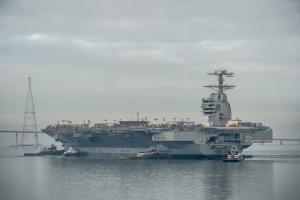By By Denise Chow, Staff Writer
10 hours ago
The U.S. Navy's newest
aircraft carrier — a massive warship outfitted with the latest radar
technology and sophisticated systems to accommodate unmanned,
carrier-launched drones — is set to undergo more than two years of
rigorous testing.
The USS Ford was christened during a special ceremony in November in
Newport News, Va. The massive warship is slated to officially enter
service in the Navy in 2016. But first, shipbuilders will spend 26
months meticulously testing the aircraft carrier's various systems.
"We're kind of in the infancy stage of the test program, and the early
returns are good," Rear Adm. Thomas Moore, program executive officer for
aircraft carriers, told the Daily Press. "We have a long way to go."
The USS Ford's testing phase is longer and more labor intensive than
normal because the next-generation warship incorporates many new
technologies, including upgraded radar systems, more efficient nuclear power plants and electromagnetic launchers designed to more effectively propel aircraft off the carrier's deck.
The mammoth USS Ford weighs nearly 100,000 tons, and will eventually be
home to more than 4,600 service people and up to 75 aircraft, according
to Newport News Shipbuilding, which constructed the aircraft carrier.
The Ford-class carriers are designed to replace the Navy's existing
Nimitz-class warships, which have been in operation since the 1970s. The
upgraded designs feature larger flight decks, three aircraft elevators
and the new ships also replace steam-powered systems with more efficient
onboard electrical power.
Some lawmakers and industry officials have criticized the USS Ford —
particularly for its $12.8 billion price tag — but the Navy is staunchly
defending the warship and its new technologies, according to the Daily
Press.
The Ford-class ships
are expected to usher in a new era of American naval power, and are
designed to operate for 50 years. Construction is already beginning on
the next aircraft carrier in the fleet, the USS John F. Kennedy.
Follow Denise Chow on Twitter @denisechow. Follow Live Science @livescience, Facebook & Google+. Original article on Live Science.
- 7 Technologies That Transformed Warfare
- Supersonic! The 10 Fastest Military Airplanes
- Flying Saucers to Mind Control: 7 Declassified Military & CIA Secrets
=====
Yahoo News


Comments